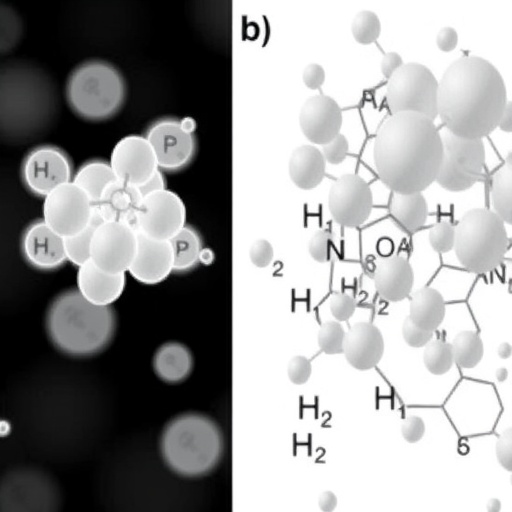In the realm of materials science, the integration of nanotechnology with polymer blends has emerged as a pivotal area of interest. Recent research conducted by Macha, Ramisetti, and Raju et al. sheds new light on the influence of silicon dioxide (SiO2) nanoparticles on the electrical conductivity of polyvinyl alcohol (PVA) and polyvinylpyrrolidone (PVP) polymer blends doped with ammonium iodide. This exploration reveals significant advancements in the understanding of how nanoscale materials can enhance the properties of conventional polymers, expanding their applications in various fields, including electronics, energy storage, and beyond.
Polymer blends are an essential component in the development of new materials, offering unique properties that are not achievable with single polymers. The synergistic effects created when blending PVA and PVP allow for the potential enhancement of mechanical strength, flexibility, and thermal stability. The addition of dopants like ammonium iodide further augments the conductivity of these blends, making them suitable candidates for various applications, including sensors and electrolytes in batteries. The recent study delves into how the introduction of SiO2 nanoparticles alters the interplay of these components, with the goal of maximizing their conductivity.
The incorporation of SiO2 nanoparticles into polymer matrices has been a focal point of scientific inquiry. SiO2 is known for its excellent insulating properties and stability, making it an intriguing candidate to study in conjunction with conductive polymer blends. By systematically varying the concentration of SiO2 nanoparticles within the PVA/PVP blend, the researchers were able to identify optimal conditions that facilitate enhanced electron mobility, which is crucial for improving overall conductivity.
One of the primary methods employed in the study is impedance spectroscopy, a powerful technique used to characterize the electrical properties of materials by analyzing their response to an alternating current. By applying this method to the polymer blends with different loads of SiO2 nanoparticles, the researchers observed distinct changes in the impedance spectra, suggesting modifications in charge transport mechanisms within the blend. This level of scrutiny provides valuable insights into how nanoparticles influence the electrical pathways of the polymer matrix.
Moreover, the study emphasizes the interactions between the SiO2 particles and the polymer host. At the nanoscale, the surface area-to-volume ratio of SiO2 nanoparticles is significantly heightened, which can lead to enhanced interaction with the polymer chains. These interactions facilitate charge transfer across the polymer matrix, which is a critical factor in achieving higher conductivity. Understanding these molecular dynamics is essential for designing materials with tailored electrical properties for specific applications.
Literature has previously documented the effects of various nanoparticles on polymer conductivity; however, the unique combination of PVA, PVP, and SiO2 nanoparticles in this study presents a fresh perspective. Researchers found that an optimal loading of SiO2—beyond which no significant enhancement in conductivity was observed—indicates that there exists a balance between sufficient nanoparticle dispersion and potential agglomeration that could hinder performance. This finding aligns with previous studies but goes further by establishing a clear parameter for effective nanoparticle loading.
Another crucial aspect of the research is the thermal analysis conducted, which aids in understanding the stability of the doped blends when subjected to different temperatures. Differential scanning calorimetry (DSC) was employed to assess the thermal transitions of the PVA/PVP blends. The introduction of SiO2 nanoparticles notably influenced the thermal properties, underscoring the nanoparticles’ role in enhancing not only electrical conductivity but also thermal stability. Such advancements are vital for applications that require materials to withstand varying environmental conditions.
In addition to thermal analysis, the mechanical properties of the developed blends were also evaluated. The researchers applied tensile testing to ascertain how the inclusion of SiO2 nanoparticles impacted the strength and flexibility of the polymer blends. Results revealed that specific concentrations of SiO2 improved the mechanical performance of the blend, indicating that the interfacial adhesion between the nanoparticles and the polymer matrix plays a significant role in enhancing the overall material properties.
The implications of this research extend far beyond basic materials science. Enhancements in electrical conductivity and mechanical stability can lead to the development of more efficient energy storage devices, such as batteries and supercapacitors, where conductivity is paramount for performance. The integration of SiO2 nanoparticles could pave the way for creating lighter, more efficient devices that capitalize on these polymer blends.
Furthermore, in the broader context of renewable energy, the potential to utilize such polymer blends as electrolytes in fuel cells or batteries addresses a vital demand in energy technology. Efficient energy storage solutions are integral to advancing electric vehicles and portable electronics, making this research pertinent to today’s technological advancements and environmental sustainability.
The researchers also discussed potential avenues for future investigation, advocating for the exploration of other nanoparticle types and their respective impacts on polymer blends. This could lead to a diverse array of conductive polymer composites tailored for specific applications, reflecting the versatility inherent in nanotechnology.
In conclusion, the study by Macha, Ramisetti, and Raju et al. significantly contributes to the understanding of how SiO2 nanoparticles can affect the electrical conductivity of PVA/PVP polymer blends doped with ammonium iodide. The intricate relationship between the nanoparticles and the polymers offers a broader basis for future research and application development in advanced material sciences. As this field continues to evolve, the potential for innovative applications underpinned by enhanced electrical properties remains vast and exciting.
Subject of Research: The impact of SiO2 nanoparticles on the electrical conductivity of PVA/PVP polymer blends doped with ammonium iodide.
Article Title: Effect of SiO2 nanoparticles on electrical conductivity studies of PVA/PVP polymer blend doped with ammonium iodide.
Article References:
Macha, B., Ramisetti, P., Raju, A. et al. Effect of SiO2 nanoparticles on electrical conductivity studies of PVA/PVP polymer blend doped with ammonium iodide.
Ionics (2025). https://doi.org/10.1007/s11581-025-06615-4
Image Credits: AI Generated
DOI: https://doi.org/10.1007/s11581-025-06615-4
Keywords: Nanoparticles, Conductivity, Polymer Blends, SiO2, PVA, PVP, Ammonium Iodide, Electrical Properties, Materials Science.




